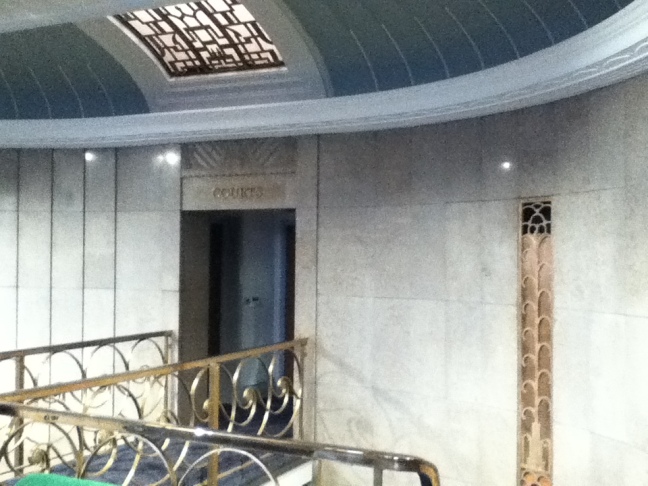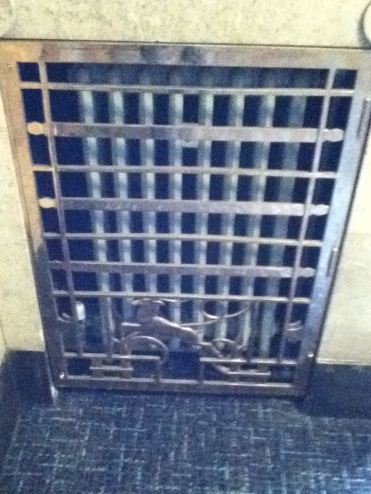Derby Local Studies Library
Quite a lot has gone on ‘behind the scenes’ over the course of this year: I’ve been working on several projects, which has involved both fieldwork and archival research.[i] It was with great relief that, after closure of the Derby Local Studies Library for a year (due to its relocation to the old Magistrate’s Court, Full Street), I was recently able to resume my research of archive material. As with other historians engaged in local studies, and many family historians, I’ve been biting my nails while awaiting the re-opening. But a visit to the library makes clear that the staff have had much work to do in order to resume services in the new venue, having reorganised the collections, and widened access to archive material.

Derby Local Studies Library (old Magistrate’s Court) interior: entrance to library, first floor
The new facilities are far superior to those in Iron Gate (now with access to a toilet, the absence of such a facility previously at times quite a problem – especially when undertaking 9-hour research sessions). The Art Deco surroundings of the old courts heighten the pleasures of exploring the fabulous collections. Location of the study room in the courtroom – complete with intact judge’s bench, along which are the digital scanners, (and above which the monarch’s coat of arms still hangs) – makes for a historically interesting environment.

Derby Local Studies Library (old Magistrate’s Court) original radiator cover on the first floor
So what have I been doing there, and in the field? My first few visits to the library were essentially ‘reccies’ to assess the available sources that I might use for the different projects on which I’m working; this involved delving into various boxes of documents, with different research questions in mind. In doing so, I saw for the first time some fabulous 18th century bills relating to protests over the sale of common land in late 18th century Derby, about which I’ll write a post in future weeks. Some of this research is part of ongoing preliminary work for the two community projects that I run; it’s also in preparation for teaching and training work; for several small independent and joint research projects; and in preparation for writing a book – the details of which I’ll discuss another time.
Previous posts have touched upon my involvement if two community archaeology projects, the first of which (that I direct), being ‘LIPCAP’ (‘Living in the Past Community Archaeology Project‘. This examines home life and environments within industrial communities in and around Derby, primarily during the 19th century (though examining 17th – mid 20th century contexts). Due to illness, LIPCAP has effectively been on hold for more than a year now, although I’ve carried out some preparatory work when able, and over the last few weeks and other members of the project team have begun to resume project activities, beginning a few weeks ago with a training session. (I hope to follow this up with another session over the next few weeks, although trying to arrange meetings around our various work schedules is proving difficult.) Research for this project has involved (and is an ongoing task) the analysis of data from previous excavations, and examining other sources to consider the home environment in the postmedieval period – with a particular interest in sanitation and waste disposal practices. Fieldwork has involved informal walk-over surveys of a local 19th – mid 20th century waste disposal site, to consider the movement and erosion of surface finds through faunal and human intrusion, and climatic forces, and to monitor the growth of vegetation, in preparation for possible field walking. I’ve also been carrying out standing building recordings for LIPCAP, developing reconstruction drawings, and am in the process of creating ‘finds’ distribution plots.
The other main project in which I’m involved (as a co-director) is Past Sense: an experimental community initiative that examines material histories of domestic and sexual violence (dating to the 17th – 20th centuries, but again focusing on the 19th century at present), while exploring approaches to integrate historical studies within trauma therapy. This work involves examining and bringing together a range of historical sources alongside archaeological material (and other material culture), including census data and parish and civil records; court and police records; newspaper and magazine archives; trade directories and advertisements; ‘cartoons’ and ballads; oral accounts and memoirs; and literature; and of course I’ve been studying previous research on the topic. Recently I’ve been searching for relevant local cases; and finding out background information of those involved in these cases. I’m considering how I might integrate this material within exhibitions and project workshops, which will also use material from other research projects (such as LIPCAP building and landscape reconstructions). I’m now working on a presentation to show case the project for the Contemporary and Historical Archaeological Theory (‘CHAT‘) conference in late October – early November.
Other research includes investigation of poverty, pauperism, and identities in the late 18th – mid 20th centuries. This involves studies of local almshouses – which again draws upon LIPCAP work, investigating a group of buildings owned by one charity in one of the LIP study areas. (These buildings are of particular personal relevance, as I was the 6th and final generation of my family to live in one of the streets of almshouses that I’m studying – as touched upon elsewhere.) But recently, my main attention has been upon workhouses, and I’m going through early 19th century parish records in order to examine the provision of ‘parish relief’ in Derby, currently focusing on All Saint’s parish (having previously examined the records of this time for the neighbouring St Alkmund’s parish, which I previously discussed here and here). As well as considering forms of ‘poor relief’, I’m evaluating some of the circumstances that led people to apply for support, and the attitudes towards the receipt and provision of assistance. This incorporates investigations into the social, economic, and political backgrounds of ‘paupers’, and of those who decided upon what was given to applicants (at this time the parish ‘overseers of the poor’, and other Vestry Committee members). I’m interested in the impact of immigration from the countryside (and influence of changes in the rural landscape), and emigration from Derby to larger industrial centres; technological development and economic decline; and social and political reform, especially the effects of the ‘New Poor Law’ of 1834; upon the provision and receipt of relief. So I’m focusing attention upon the time after the Napoleonic wars (a period in which there were times of high unemployment), to the 1840s (when movements such as Chartism may have substantially effected working conditions, gender relationships, and domestic economy).[i] After going through these records, I’ll examine those for the other borough parishes of St Michael, St Werburgh, and St Peter. This will add to the work I’m doing on crime and poverty in the area during the 17th – 20th centuries; and home, family, and community – evaluating gender relationships (which informs PSP research, as with this case study: of a mother and children who had to go into the workhouse after desertion by the father).
I’m also investigating local burial practices, examining changes in the early – mid 19th century, due to urban change and population growth leading to graveyard ‘overcrowding’, and going through the records in search of examples of ‘body snatching’, considering the impact of the Anatomy Act of 1832. In part, this is to inform a co-authored research paper that I’m writing, which discusses the attitudes of artist Joseph Wright, and intellectual Erasmus Darwin, towards burial and dissection in the late 18th century.[ii] As well as archival research, this has involved regular forays into local graveyards to examine mortuary memorials (snapshots from which I’ve put online here) – which will also enhance PSP research (in evaluating the burial of victims of domestic abuse, especially women murdered by their husband – as mentioned here), and will inform my research on poverty and workhouses, and crime and punishment. Earlier in the year, I also returned briefly to research on ‘slave ownership’ in 18th century Derby (which I began a few years ago after encountering evidence that it might be useful to contextualise and write up), and found a few more leads; however, having again hit a dead end, I shall have to return to this at a later date. (This again crosses over with the work of the other authors with whom I work and discuss subject matter, who approach the material from different – primarily Art Historical – perspectives.)
[Edited 12 Sept. 2015: I neglected to mention my interest in the ‘past in the past’ in the 18th and 19th centuries in particular, following on from my previous work on this topic for the Roman and Early Medieval periods (which can be found here, here, and here). I’m interested in the use and reproduction of ‘ancient’ landscape features (including prehistoric and Roman burial mounds, and caves: I’ve begun to informally survey the distribution of ceramics within country parks, and at monuments in Derbyshire and Oxfordshire – though have yet to develop this research on a more systematic basis), and the idealisation of a pre-industrial ‘Golden Age’ (as in the construction of Medieval style buildings – as here), and considering influence of these ideas in the decoration of ceramics. The latter links to my work with PSP.]
It can hopefully be seen that, though at first seeming unrelated, these different projects cross over at various points: I’ve found many of the sources that I examine to be of use for several of the different studies in which I’m engaged. As mentioned above, I’m planning a book, which will bring some aspects of these topics together; however, there’s much research yet to do, so it’ll be a while before I’m anywhere near to completion of this work. I also intend to integrate this work within tours, lectures, and workshops. So, I have plenty to be going on with; and when time permits, I’ll provide updates here on the discoveries and developments made through these different strands of inquiry.
[Edited 12 Sept. 2015: I also intended to explain why I’m changing the name of this blog: this is to reflect the broader topics covered by my research.]
Notes
[i] Some may not realise why and how archaeologists can spend many hours at the Local Studies Library or Public Record Office; for those unfamiliar with processes of archaeological inquiry, I’ll provide a brief explanation elsewhere as to why archival is an essential component of archaeological research.
[ii] An interesting study on this topic, which has given much food for thought, is Anna Clark’s 1997 The Struggle for the Breeches: Gender and the Making of the British Working Class.
[iii] I’m also collating the archaeological evidence that relates to the life of the painter, with a view to producing another paper on the topic.; and I’ve been working on another paper with the same co-author about the well-known archaeologist R.E. Mortimer Wheeler, but that’s on hold until we can track down a last piece of evidence. I’ll return to these topics in future posts.
